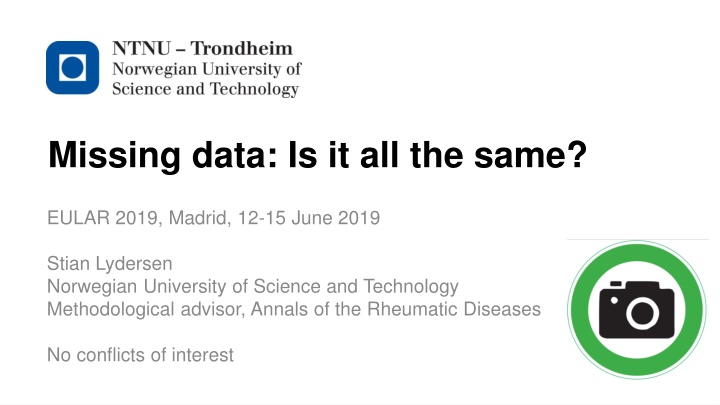
Missing Data: Types, Mechanisms, and Implications
Delve into the world of missing data, exploring its types, mechanisms, and impact on research outcomes. Learn about MCAR, MAR, and MNAR mechanisms, and discover the plausibility and implications of MAR assumptions. Uncover traditional and recommended methods for handling missing data, such as single imputation and multiple imputation, and their implications on analysis results. Gain insights into the importance of proper data handling techniques in research studies.
Download Presentation

Please find below an Image/Link to download the presentation.
The content on the website is provided AS IS for your information and personal use only. It may not be sold, licensed, or shared on other websites without obtaining consent from the author. If you encounter any issues during the download, it is possible that the publisher has removed the file from their server.
You are allowed to download the files provided on this website for personal or commercial use, subject to the condition that they are used lawfully. All files are the property of their respective owners.
The content on the website is provided AS IS for your information and personal use only. It may not be sold, licensed, or shared on other websites without obtaining consent from the author.
E N D
Presentation Transcript
Missing data: Is it all the same? EULAR 2019, Madrid, 12-15 June 2019 Stian Lydersen Norwegian University of Science and Technology Methodological advisor, Annals of the Rheumatic Diseases No conflicts of interest Norwegian University of Science and Technology
Missing data: Holes in the data matrix which ideally should be complete Usually, these are data we intended to collect, but for some reason did not. There exists a meaningful value which was not recorded. Norwegian University of Science and Technology 2
Type of missing data (Missing data Mechanism) The probability that a data value is missing (unobserved) can depend on MCAR Missing Completely at Random Neither observed nor unobserved values MAR Missing at Random (Ignorable nonresponse) Only observed values MNAR Missing Not at Random (Nonignorable nonresponse) Unobserved values (and observed values) Norwegian University of Science and Technology 3
Plausibility and implications of MAR Planned missingness is usually MCAR or MAR Based on the observed data, there is no way to test if MAR holds. MAR is an unverifiable assumption In some situations, erroneous assuming MAR has small impact on results. Generally, assuming MAR introduces less bias than assuming MCAR. Norwegian University of Science and Technology 4
Some traditional methods and some recommended methods. (Unbiased when) Complete case analysis, available case analysis (MCAR) Single imputation Mean substitution (never) Averaging available items on a scale (?) LOCF (Last Observation Carried Forward) (never) Defining missing as a data value (never) Proper single imputation such as the EM (Expectation-Maximation algortithm) (MAR but underestimates uncertainty) Multiple Imputation (MI) (MAR) Full model based analysis (full information maximum likelihood) (MAR) Linear Mixed model (MAR) Norwegian University of Science and Technology 5
Averaging available items on a scale Example: 36-Item Short Form Survey (SF-36) is a generic quality of life instrument. Eight scales with 2 to 10 items each: physical functioning role limitations due to physical problems bodily pain general health perceptions Vitality Social functioning role limitations due to emotional problems mental health Recommended in the manual: On each scale, compute the average score if at least 50% of the items are available Norwegian University of Science and Technology 6
Last observation carried forward (LOCF) Figure from Lydersen (2019) Norwegian University of Science and Technology 7
Last observation carried forward (LOCF) Used to be recommended in RCT, believed to be conservative. But LOCF can give bias in both directions, and can give bias even if data are MCAR. LOCF is neither valid under general assumptions nor based on statistical principles, and should not be used. LOCF is attractive because it is simple, but it has little else to recommend it (Vickers and Altman, BMJ, 2013) See Lydersen (2019) and references therein Norwegian University of Science and Technology 8
Thank you for your attention Norwegian University of Science and Technology 10
